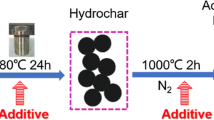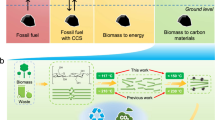Abstract
The paper presents a systematic study of the formation of carbon nanofoam from sucrose by hydrothermal carbonization. It is shown that for the process temperature of 150 °C, carbonization is not a gradual process but rather occurs suddenly at a specific threshold time of 4.5 h. pH value and electrical conductivity (EC) of the sucrose solution were monitored during carbonization. In the first 4.5 h prior to carbonization, the sucrose solution shows a sharp drop from pH 7.8 to pH 2 and sharp increase of EC. From this point on the values of pH and EC remain approximately constant. After the 4.5 h threshold, we examined the evolution of mass yield, density and morphology of the resulting carbon nanofoam. The yield first shows a steep increase around 4.5 h and then a further gradual increase up to 38% at 54.6 h. The mass density just after the 4.5 h threshold is 0.28 g/cm3 and decreases with process time to reach a constant value of 0.14 g/cm3, between 20 and 54.6 h. This shows that desired conditions, such as low density and high yield, are obtained with sufficient process time below 5 h. Due to the release of intermediates of the conversion reaction into the sucrose solution, both pH and EC were found to be excellent indicators for the progression of hydrothermal carbonization.






Similar content being viewed by others
References
Sattler KD (ed) (2020). 21st century nanoscience – a handbook: low-dimensional materials and morphologies (volume four), 1st edn. CRC Press, Boca Raton
Sattler KD (ed) (2016). Carbon nanomaterials sourcebook, two-volume set, 1st edn. CRC Press, Boca Raton
Wortmann M et al (2020). Chemical and morphological transition of poly(acrylonitrile)/poly(vinylidene fluoride) blend nanofibers during oxidative stabilization and incipient carbonization. Nanomaterials 10(6):1210
Liu C et al (2017). Facile synthesis of nickel nanofoam architectures for applications in li-ion batteries. Energ Technol 5(3):422–427
Iwu KO et al (2016). Facile synthesis of Ni nanofoam for flexible and low-cost non-enzymatic glucose sensing. Sens Actuators B-Chem 224:764–771
Lacerda JN et al (2020). Manganese oxide nanofoam prepared by pulsed laser deposition for high performance supercapacitor electrodes. Mater Chem Phys 242:122459
Iino T, Nakamura K (2009). Acoustic and acousto-optic characteristics of silicon nanofoam. Jpn J Appl Phys 48(7):07GE01
Jia H et al (2015). Deep eutectic solvent-assisted growth of gold nanofoams and their excellent catalytic properties. J Mol Liq 212:763–766
Dutta A et al (2018). Beyond copper in co2 electrolysis: effective hydrocarbon production on silver-nanofoam catalysts. ACS Catal 8(9):8357–8368
Lamaison S et al (2019). Zn-Cu alloy nanofoams as efficient catalysts for the reduction of co2 to syngas mixtures with a potential-independent h-2/co ratio. Chemsuschem 12(2):511–517
Jo H et al (2014). Novel method of powder-based processing of copper nanofoams for their potential use in energy applications. Mater Chem Phys 145(1–2):6–11
Vukovic I et al (2011). Supramolecular route to well-ordered metal nanofoams. ACS Nano 5(8):6339–6348
Bartunek V et al (2017). Facile synthesis of magnetic Co nanofoam by low-temperature thermal decomposition of Co glycerolate. Micro Nano Lett 12(5):278–280
Grant-Jacob JA, Mills B, Eason RW (2014). Parametric study of the rapid fabrication of glass nanofoam via femtosecond laser irradiation. J Phys D-Appl Phys 47(5):055105
Manzo DJ et al (2019). Structural and compositional analysis of GaSb nanofoams obtained by ion irradiation of sputtered films. Thin Solid Films 687:137447
Levesque A et al (2004). Monodisperse carbon nanopearls in a foam-like arrangement: a new carbon nano-compound for cold cathodes. Thin Solid Films 464:308–314
Sattler KD (ed) (2016). Carbon nanomaterials sourcebook: graphene, fullerenes, nanotubes, and nanodiamonds (volume one), 1st edn. CRC Press, Boca Raton
Sattler KD (ed) (2016). Carbon nanomaterials sourcebook: nanoparticles, nanocapsules, nanofibers, nanoporous structures, and nanocomposites (volume two), 1st edn. CRC Press, Boca Raton
Tekin K, Karagoz S, Bektas S (2014). A review of hydrothermal biomass processing. Renew Sustain Energy Rev 40:673–687
Funke A, Ziegler F (2010). Hydrothermal carbonization of biomass: A summary and discussion of chemical mechanisms for process engineering. Biofuels Bioprod Bioref-Biofpr 4(2):160–177
Hu B et al (2010). Engineering carbon materials from the hydrothermal carbonization process of biomass. Adv Mater 22(7):813–828
Titirici MM et al (2007). A direct synthesis of mesoporous carbons with bicontinuous pore morphology from crude plant material by hydrothermal carbonization. Chem Mater 19(17):4205–4212
Khan TA et al (2019). Synthesis and characterization of carbon microspheres from rubber wood by hydrothermal carbonization. J Chem Technol Biotechnol 94(5):1374–1383
Fuertes AB et al (2010). Chemical and structural properties of carbonaceous products obtained by pyrolysis and hydrothermal carbonisation of corn stover. Aust J Soil Res 48(6–7):618–626
Gupta A, Kour R, Brar LK (2019). Facile synthesis of carbon nanospheres from saccharides for photocatalytic applications. Sn Appl Sci 1(10):1–8
Sevilla M, Fuertes AB (2009). Chemical and structural properties of carbonaceous products obtained by hydrothermal carbonization of saccharides. Chemi-a Eur J 15(16):4195–4203
Frese N et al (2017). Diamond-like carbon nanofoam from low-temperature hydrothermal carbonization of a sucrose/naphtalene precurson solution. J Carbon Res 3:23
Mi YZ et al (2008). Synthesis of carbon micro-spheres by a glucose hydrothermal method. Mater Lett 62(8–9):1194–1196
Sevilla M, Fuertes AB (2009). The production of carbon materials by hydrothermal carbonization of cellulose. Carbon 47(9):2281–2289
Cheng YL et al (2017). Controllable morphologies of carbon microspheres via green hydrothermal method using fructose and xylose. Chem Lett 46(9):1400–1402
Lagazzo A et al (2016). Hydrothermal synthesis of pectin derived nanoporous carbon material. Mater Lett 171:212–215
Mitchell ST et al (2015). Ultralight carbon nanofoam from naphtalene-mediated hydrothermal sucrose carbonization. Carbon 95:434–441
Zhao HY et al (2017). Effects of additives on sucrose-derived activated carbon microspheres synthesized by hydrothermal carbonization. J Mater Sci 52(18):10787–10799. https://doi.org/10.1007/s10853-017-1258-4
Chen JZ et al (2012). Calcium-assisted hydrothermal carbonization of an alginate for the production of carbon microspheres with unique surface nanopores. Mater Lett 67(1):365–368. https://doi.org/10.1016/j.matlet.2011.10.017
Wortmann M et al (2020). On the reliability of highly magnified micrographs for structural analysis in materials science. Sci Rep 10(1):1–8
Smith M et al (2016). Improving the deconvolution and interpretation of XPS spectra from chars by ab initio calculations. Carbon 110:155–171
Baccile N et al (2009). Structural characterization of hydrothermal carbon spheres by advanced solid-state mas c-13 nmr investigations. J Phys Chem C 113(22):9644–9654
Lide DR (2005). CRC handbook of chemistry and physics, 86th edn. CRC (FL) Press, Baco Raton
Hao SW et al (2016). Activated carbon derived from hydrothermal treatment of sucrose and its air filtration application. RSC Adv 6(111):109950–109959
Qi YJ et al (2016). Mechanism for the formation and growth of carbonaceous spheres from sucrose by hydrothermal carbonization. RSC Adv 6(25):20814–20823
Wang Q et al (2001). Monodispersed hard carbon spherules with uniform nanopores. Carbon 39(14):2211–2214
Simsir H, Eltugral N, Karagoz S (2017). Hydrothermal carbonization for the preparation of hydrochars from glucose, cellulose, chitin, chitosan and wood chips via low-temperature and their characterization. Biores Technol 246:82–87
Frese N et al (2016). Fundamental properties of high-quality carbon nanofoam: from low to high density. Beilstein J Nanotechnol 7:2065–2073
Nizamuddin S et al (2017). An overview of effect of process parameters on hydrothermal carbonization of biomass. Renew Sustain Energy Rev 73:1289–1299
Author information
Authors and Affiliations
Corresponding author
Ethics declarations
Conflicts of interest
The authors did not receive support from any organization for the submitted work. No funding was received to assist with the preparation of this manuscript. No funding was received for conducting this study. No funds, grants, or other support was received.
Additional information
Handling Editor: Gregory Rutledge.
Publisher's Note
Springer Nature remains neutral with regard to jurisdictional claims in published maps and institutional affiliations.
Rights and permissions
About this article
Cite this article
Brooks, C., Lee, J., Frese, N. et al. Process time variation and critical growth onset analysis for nanofoam formation in sucrose-based hydrothermal carbonization. J Mater Sci 56, 15004–15011 (2021). https://doi.org/10.1007/s10853-021-06222-4
Received:
Accepted:
Published:
Issue Date:
DOI: https://doi.org/10.1007/s10853-021-06222-4




